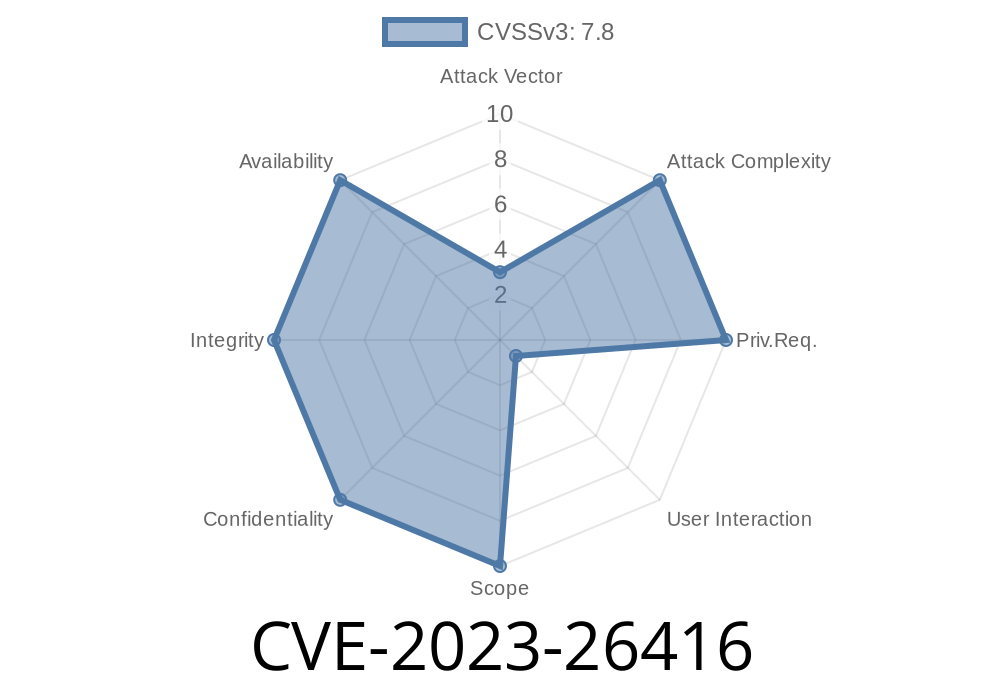Adobe Substance 3D Designer is a popular software for creating 3D materials and textures, widely used in gaming, movies, and visual design. In 2023, a critical security issue (CVE-2023-26416) was discovered in this software that could allow an attacker to execute malicious code on a victim's computer simply by tricking them into opening a specially crafted file. In this post, we’ll break down the vulnerability, demonstrate the risk with real code, and give you links and guidance to protect yourself.
What is CVE-2023-26416?
CVE-2023-26416 is a heap-based buffer overflow vulnerability found in Adobe Substance 3D Designer version 12.4. and earlier. This vulnerability makes it possible for attackers to execute arbitrary code — meaning malware, ransomware, or anything else — with the same privileges as the user.
How Does the Vulnerability Work?
A heap-based buffer overflow happens when the software writes more data to a buffer located on the heap than what is actually allocated. If the program doesn’t check the length or type of the data it is reading (for example, from an imported file), it could overwrite critical data in memory.
Imagine that Substance 3D Designer loads a .sbs (Substance) file containing material properties. If the file contains malformed data — say, a very long string or too many values — and the software doesn’t check their size before copying them to a buffer, it will overflow and possibly write attacker-controlled payloads into memory. On modern systems, attackers use buffer overflows to overwrite function pointers or virtual tables (vtable), then hijack the control flow when the program tries to run one of those functions.
Here’s a simplified C++ example of how this kind of bug can happen
void loadMaterialName(std::ifstream &file) {
char materialName[128];
file.read(materialName, 256); // Vulnerable: reading 256 bytes into a 128-byte buffer
materialName[127] = '\'; // Null-terminate (but that's too late)
printf("Material Name: %s", materialName);
}
If the attacker crafts a file that sends 256 bytes to this function, it will overflow materialName and corrupt adjacent memory. On a real app like Adobe Substance 3D Designer, the overflow can end up overwriting objects on the heap, allowing code redirection.
Attacker crafts a malicious .sbs file
The attacker creates a .sbs file with a malformed material name property, filling it with 256+ “A” characters followed by special binary data (a payload or ROP chain).
Victim opens the file
The user (designer, artist, etc) opens this file in Substance 3D Designer, maybe trusting it as an asset shared by another artist.
Heap overflow occurs
The application, while reading the malicious file, copies the oversized string into a smaller buffer, overwriting heap memory.
Hijack happens
If the attacker is clever, the overflow will let them control a function pointer or vtable. When the program later makes a call, it jumps to the attacker’s code instead of a real function.
Payload runs
Arbitrary code executes with the same privileges as the user, resulting in data theft, malware, or lateral movement.
Sample Exploit File Structure
# This is a pseudocode 'poison' Substance file for demo purposes.
with open("malicious_material.sbs", "wb") as f:
# Write Substance Designer header (simple example)
f.write(b'SBSD') # Header
# Overlarge material name
f.write(b'A' * 256) # Overflow buffer
# Attacker's shellcode or control data would come here
f.write(b'\x90' * 50 + b'\xcc' * 10) # NOP sled and breakpoints for demo
# Rest of file structure goes here
This would trigger the vulnerable code path when opened.
Official Reference Links
- Adobe Security Bulletin (APSB23-14)
- NIST CVE Summary for CVE-2023-26416
- CVE Details CVE-2023-26416
How to Stay Safe
Update your software:
Adobe has released updates to patch this issue. Download the latest version of Substance 3D Designer from Adobe's official website.
Be cautious with files:
Do not open substance files (.sbs) from untrusted sources.
User privilege management:
Run applications as a standard user, not admin, to limit exploitation impact.
Enable exploit protections:
Use security tools like antivirus and endpoint detection and response (EDR).
Final Thoughts
CVE-2023-26416 shows how even creative tools can be a vector for serious cyber attacks if they have hidden memory bugs. Security is everyone’s concern — artists and IT admins alike.
If you use Adobe Substance 3D Designer and haven’t updated, do it now. Vulnerabilities that require just a double-click to trigger are among the most dangerous in the wild.
Stay safe!
*If you found this breakdown helpful, share it with your creative tech friends to keep the community secure. For more details, visit the official Adobe security page or check the National Vulnerability Database (NVD).*
Disclaimer: The code samples above are for educational purposes only. Do not attempt exploitation on systems you do not own or have permission to test.
Timeline
Published on: 04/13/2023 20:15:00 UTC
